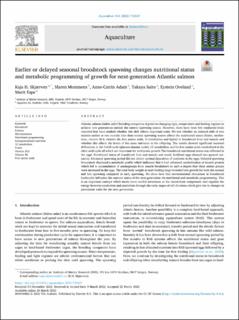Earlier or delayed seasonal broodstock spawning changes nutritional status and metabolic programming of growth for next-generation Atlantic salmon
Skjærven, Kaja Helvik; Mommens, Maren; Adam, Anne-Catrin; Saito, Takaya; Oveland, Eystein; Espe, Marit
Peer reviewed, Journal article
Published version
Permanent lenke
https://hdl.handle.net/11250/3005051Utgivelsesdato
2022Metadata
Vis full innførselSamlinger
- Articles [3012]
- Publikasjoner fra CRIStin [3070]
Sammendrag
Atlantic salmon (Salmo salar) breeding companies depend on changing light, temperature and feeding regimes to achieve new generations outside the natural spawning season. However, there have been few conducted trials reported that have studied whether this shift affects important traits. We test whether an induced shift of two months earlier or two months later than normal spawning season affects the nutritional status (folate, methionine, vitamin B12, vitamin B6, free amino acids, N-metabolites and lipids) in broodstock liver and muscle and whether this affects the levels of the same nutrients in the offspring. The results showed significant seasonal differences in the Cahill cycle (glucose-alanine cycle), 1C metabolism and for free amino acids catabolized in the citric acid cycle all which are important for embryonic growth The broodstock nutritional status was reflected in the eggs. Nutritional status of broodstock liver and muscle and newly fertilized eggs showed two general scenarios: Advanced spawning period did not obtain optimal deposition of nutrients in the eggs. Delayed spawning broodstock displayed a metabolic profile which indicated that it had enhanced catabolization of muscle protein which led to accumulation of aminogroups from muscle breakdown to such a degree that these amino groups were increased in the eggs. The total body weight at start-feeding stage revealed best growth for both the normal and late spawning compared to early spawning. We show here that environmental alterations in broodstock husbandry influence the nutrient status of the next generation via nutritional and metabolic programming. This is an important concept which needs more careful awareness as the metabolism compensate and regulate the energy between catabolism and anabolism through the early stages of cell divisions which give rise to changes in permanent traits for the next generation.
